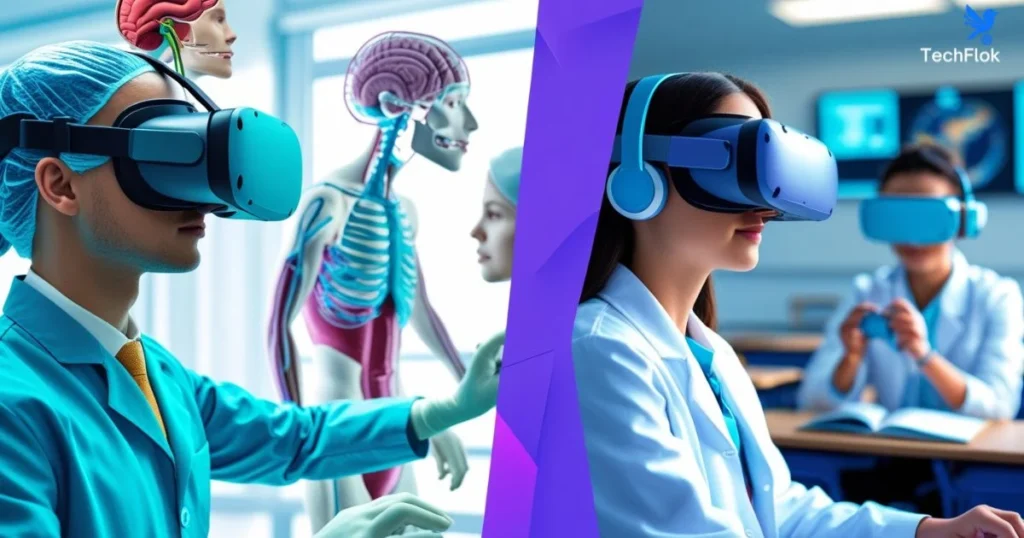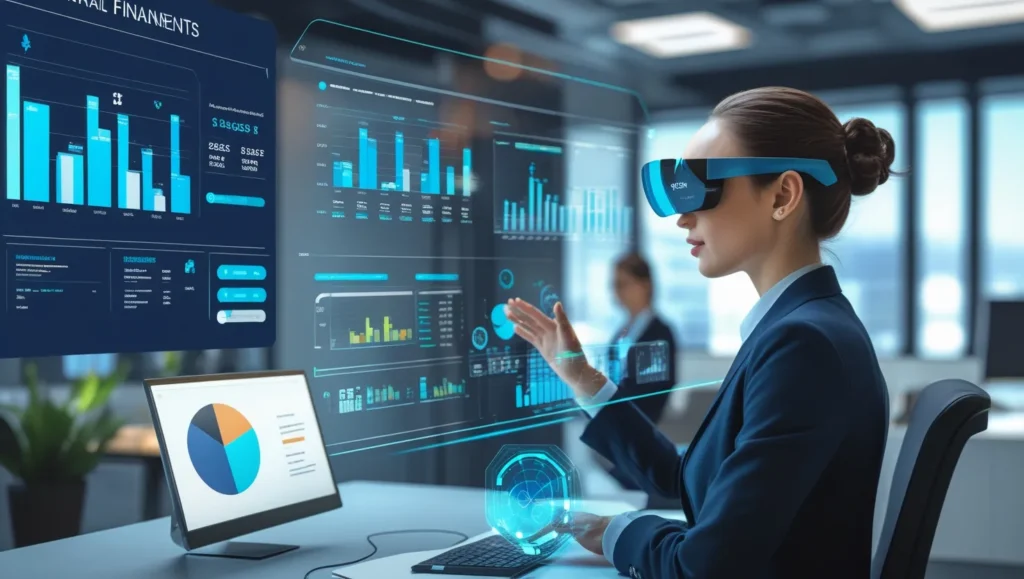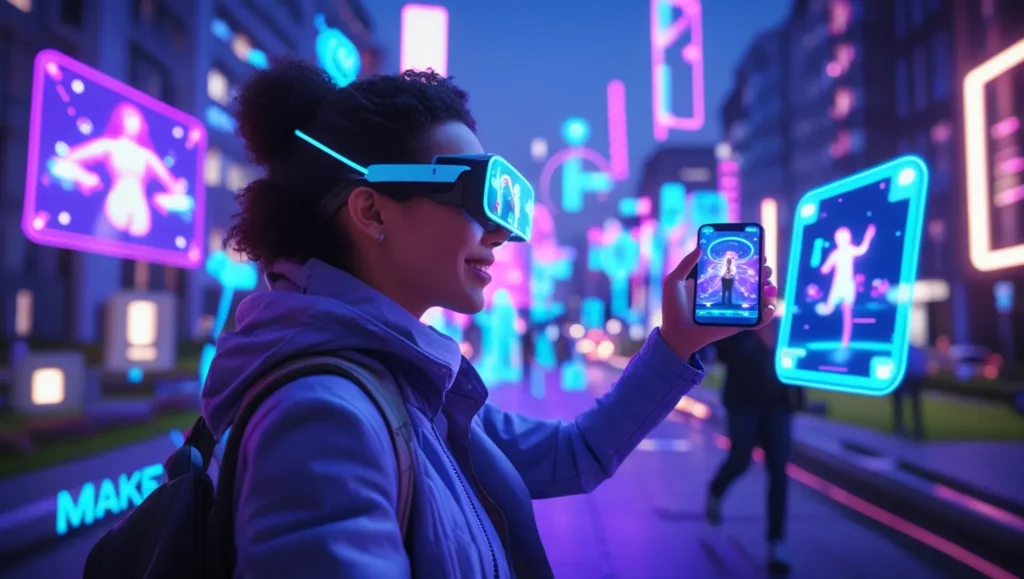
Virtual Reality Technology is a technique that produces immersive computer-generated environments in which people can interact in real-time. Through the stimulation of sound, sight, and even the touch of a finger, VR places people inside a simulated environment, rather than displaying the space on screens.
Over seven decades of research and development, beginning with stereoscopes and the first immersive theaters, have led to today’s head-mounted displays, haptic controls, and mixed reality devices.
This guide summarizes the entire array of information you provided to the reader, including definitions, background, technical details, applications, advantages, and risks. It also provides real-world scenarios for selecting or utilizing VR systems.
What is Virtual Reality Technology?
VR Technology is a 3-D, computer-generated space for users to explore and use. When a person puts on a VR device, typically a head-mounted display (HMD), the virtual world controls their auditory and visual senses. It can create the feeling of being in the moment, the psychological sensation that comes from “being there.”
Concepts at the core:
- Immersion: how completely a system alters the user’s perception of the real world through virtual Reality. More intense immersion requires synchronised visual and audio, and sometimes tactile feedback.
- Interactivity refers to how users can control and alter their virtual surroundings (gestures or controllers, motion systems).
- Presence is an experience that is subjective in “being” in the virtual environment instead of viewing it.
VR vs AR vs MR
- Augmented Reality (AR): overlays digital objects onto actual Reality (it adds information to the Reality). Examples include smart glasses that show live warehouse data in real-time.
- Mixed Reality (MR): Blends virtual and real worlds, allowing real and digital objects to coexist and interact in real-time.
- Virtual Reality (VR): replaces real surroundings completely with digital ones.
Although the terms are interchangeable, their technical distinctions are important when selecting hardware and creating experiences.
How Virtual Reality Technology Works
This section is broken down into Virtual Reality systems, software, hardware, and the real-time processing processes that create an immersive experience.
2.1 Inputs and Tracking
- Trackers and sensors collect motion data from users. Tracking could be:
- Outside-in (external tracker): Cameras or base stations track markers on headsets and controllers (e.g., HTC Lighthouse, Valve systems).
- Inside-out (on-device tracking): Cameras and sensors in the headset monitor the surrounding environment as well as the movement of the user.
- 3DoF (three degrees): rotational movements only (yaw, roll, pitch). It is a feature found on basic mobile VR viewers.
- 6DoF (six degrees): full positional and rotational tracking (forward/backwards, left/right, and up/down) that allows for freedom of movement in space.
2.2 Rendering and Display Pipeline
- Scene rendering. An engine, or VR program, creates two distinct images for each eye to recreate the depth (stereoscopy).
- Pre-distortion: The rendered frames are pre-distorted to adjust for lens characteristics, so that users can experience a clear virtual world.
- Frames with a low frame timing, high Refresh rates that are long-lasting, decrease blur and motion blurring. Many VR systems aim for 90 frames per second (FPS) as a base for a comfortable experience.
- Management of latency: Minimising the time between head movement and display photo (motion-to-photon delay) is crucial to lessen VR sickness.
2.3 Audio and Haptics
- Spatial (binaural) audio places sound in 3D space, to match the visuals.
- Haptic feedback (vibration or force wearable haptics) offers touch signals. Full-body suits and advanced haptics are designed to mimic the feel of weight, texture, and force.
2.4 Locomotion & Input
- Controllers are portable devices designed for grasping, pointing, and other gestures. Some systems track individual fingers.
- Gloves and Suits: allow for finger tracking and feedback on force.
- Treadmills and locomotion systems: omnidirectional treadmills allow walking in a stationary position while the avatar moves.
2.5 The “Sense of Presence”
An adequately designed VR setup is synchronized with the tracking, visual fidelity, audio, and haptic clues. When these cues are aligned with the human sense of perception, users feel presence. They respond to, move, and behave as if the virtual world were real.
Technology & Components
3.1 Headsets and Displays
- Head-mounted displays (HMDs): the primary output device. They contain two displays (one for each eye) or a single screen divided by optics.
- Display types: OLED and LCD were common; modern devices also use advanced optics such as Fresnel and pancake lenses (thinner optical stacks).
- Field of View (FOV): A wider FOV increases immersion. The human visual system spans roughly 200–220 degrees, but practical HMDs currently cover only a portion.
- Resolution & MAR: Minimal Angle of Resolution (MAR) determines how close pixels must be before they’re indistinguishable. Higher effective spatial resolution reduces the “screen door” effect.
3.2 Lenses, Optics, and Visual Comfort
- Lenses bring displays into focus and introduce distortion that software pre-corrects.
- Vergence–Accommodation Conflict (VAC): occurs when the eyes converge at one distance while focal depth differs on the display, contributing to eye strain and VR sickness. Future optics and varifocal displays aim to reduce VAC.
3.3 Tracking Systems
- External base stations (outside-in): provide robust room-scale tracking with high precision.
- Inside-out tracking: uses cameras and SLAM-like algorithms to map the environment and track movement without external sensors.
3.4 Haptics & Force Feedback
- Simple haptics: controller vibrations and rumble.
- Advanced haptics: wearable suits, gloves, and multi-string devices that simulate tension and contact.
- Force feedback: Exoskeletons or resistance platforms can simulate massive objects or impacts.
3.5 Peripherals & Capture
- 360°/omnidirectional cameras capture immersive video and photography.
- Photogrammetry combines high-resolution photographs to generate realistic 3D models for VR scenes.
3.6 Software Stack & Standards
- Game engines (commonly used tools) render VR content in real time.
- Legacy/web standards: VRML and X3D were early efforts for 3D web content. WebVR paved the way for browser-based device support.
Types of Virtual Reality Technology
4. 1 Non-Immersive VR
Desktop-based 3D simulations and worlds are displayed on a monitor. For example, the standard computer games are first-person.
4.2 Semi-Immersive VR
The large-screen displays, the training simulators, or driving/pilot instruction with real-life controls. They offer a sense of immersion but do not block the real world.
4.3 Fully Immersive VR
The headset-based experience blocks out the real world. The most common Gaming systems and training simulators use headsets with 6 DoF or tracked controls.
4.4 Augmented and Mixed Reality (related forms)
Although technically different technologies, VR and AR are closely related; MR devices like mixed-reality headsets enable VR objects to be tied to real-world positions and interact with them.
Brief History of Virtual Reality Technology
This timeline outlines key milestones in the evolution of gadgets.
Pre-20th Century – Early Precursors
- Stereoscope and perspectiva art Renaissance advancements, and the stereoscope set the scene for illusions of depth.
1950s-1960s — Sensorama & Early HMDs
- Morton Heilig’s Sensorama (1962): an immersive multisensory theatre with a mechanical design.
- Ivan Sutherland’s Sword of Damocles (1968): the first head-mounted projection system (cumbersome and attached to the ceiling).
1970s-1980s — Research & Specialized Systems
- NASA, as well as research laboratories, explored the first interactive simulators and early virtual worlds.
- Large Expanse Extra Perspective (LEEP) and the VIEW system offered wide FOV stereographic imaging to support NASA research.
Late 1980s-1990s — Commercial Experiments
- Jaron Lanier and VPL Research became the first to popularise the concept of “virtual reality.” Devices like the Data Glove and the early HMDs were introduced.
- Virtuality arcade systems and CAVE projection rooms were the first to offer games and a large-scale experience.
- Consumer-oriented attempts: Sega VR prototypes, Nintendo Virtual Boy, and PC headsets such as the VFX-1 came out, but could not overcome technological and market limitations.
2000s — Quiet Progress & New Tools
- SAS Cube, as well as Virtools VRPack, offer advanced immersive rooms for PCs. Google Street View (2007) featured worldwide panoramas.
2010s — The Modern Resurgence
- In 2010, Palmer Luckey designed an Oculus Rift prototype. The 2012 Kickstarter campaign and E3 exposure followed.
- 2014. The acquisition by Facebook and Meta of Oculus (reported at 3 billion dollars).
- 2015-2016 HTC Vive, Sony Project Morpheus/PlayStation VR, and mobile alternatives such as Samsung Gear VR increased the adoption rate.
2019-2024 — Standalone Headsets & Mixed Reality
- Standalone Oculus/Meta Quest series that popularised VR without tethering (Quest, Quest 2).
- Innovations: Valve Index introduced advanced controllers and a larger FOV. Meta Quest Pro targets mixed Reality. PlayStation VR2 (2023) introduced eye tracking and haptic-adaptive triggers. Apple Vision Pro (2024) introduced a spatial computing method built around high-quality video passing through.
- Certification for Training: Loft Dynamics’ VR flight simulators have obtained certifications from EASA and the FAA, showing the development of VR within regulated industries.
Applications of Virtual Reality Technology
Gaming and Entertainment
Virtual Reality can revolutionize gaming by providing immersive environments where gamers can play in three dimensions. Some examples of this are VR games like the Oculus Quest Series, PlayStation VR2, and Valve Index, which provide features like finger tracking, a wide field of view, and haptic feedback for an unbeatable experience.
Education and Training
From virtual classrooms to real-world flying simulators. VR can be utilized to train people in controlled, safe settings. Loft Dynamics’ VR-based flight simulators, which EASA and FAA approve, permit pilots to test risky manoeuvres without risking lives or the equipment.
Healthcare

VR can be used in physical therapy, pain management, and surgical training. Medical students can practice their procedures using virtual Reality, reducing the costs and risks of traditional techniques.
Architecture and Design
Architects utilize VR to design interactive, walkable models of buildings, which allow clients to experience the spaces before they’re constructed.
Military and Law Enforcement
Training simulations can be used for simulations of missions and awareness exercises in real-world environments.
Challenges and Limitations of Virtual Reality
- Motion sickness: Motion tracking that is not in sync or lags may cause nausea.
- Prices are high: Premium VR headsets and powerful computers remain costly.
- Limited content: Even though it’s growing, the library of VR content is not as extensive as traditional media.
- Physical Space requirements: Room-scale VR requires a safe area for movement.
- Hardware comfort: Extended use can result in discomfort from the headset’s weight or the heat.
Future of Virtual Reality Technology
The future is pointing towards smaller headsets, better resolutions, natural haptic feedback, and adaptive artificial intelligence-driven environments. Companies such as Meta, Apple, Sony, and Valve are innovating in multisensory, integrated Reality along with wireless models.
Expect a deeper integration into sectors like remote work, tourism, telemedicine, and the metaverse, where VR is as widespread as smartphones.
Conclusion
Virtual Reality is no longer a science fiction idea. It’s an emerging technology changing how we learn, work, play, and recover. With a range of realistic simulators for flight used for pilot training, immersive games, and virtual classes, VR offers previously unattainable experiences. The capability to create secure, efficient, cost-effective, and enjoyable environments makes it an effective tool for all industries that range from education to healthcare to entertainment.
However, just like all technology, Virtual Reality comes with problems, like expensive equipment, motion sickness, and the possibility of being overused. As technology advances, VR becomes more affordable, cost-effective, and realistic, opening up new opportunities. It doesn’t matter if you’re exploring far-off environments, gaining new skills, or interacting with people through virtual space. VR opens up a new realm of interaction where the imagination is truly a part of Reality.
FAQs:
1. What do you mean by virtual Reality?
Virtual Reality (VR) is a computer-generated simulation that immerses you in a three-dimensional, interactive environment, often experienced through a headset and motion-tracking technology.
2. What is an example of a virtual reality?
A popular example of VR is Beat Sabre, a rhythm game played using VR headsets where players slash music beats with virtual lightsabers.
3. Is virtual Reality a good or bad thing?
VR can be good and bad — it’s great for education, training, therapy, and entertainment, but overuse may cause eye strain, motion sickness, and reduced physical activity.
4. How does virtual Reality work?
VR combines specialised headsets, motion sensors, and 3D graphics to track your movements and render a responsive virtual environment in real-time, creating the feeling of “being there.”
5. What is the best VR on the market?
As of 2025, top contenders include Meta Quest 3, Valve Index, and Sony PlayStation VR2, each offering high-quality visuals and advanced tracking.
6. Do you have to put your phone in a VR?
Not always. Entry-level VR, like Google Cardboard, uses a phone, but high-end VR headsets, like Meta Quest or HTC Vive, are standalone or connected to a PC/console.
7. What kind of computer do I need for VR?
For PC VR, you’ll need a powerful computer with at least:
CPU: Intel i5/Ryzen 5 or higher
GPU: NVIDIA GTX 1660 / AMD RX 590 or better
RAM: 8GB+
USB & HDMI/DisplayPort connections
8. Do you have to connect a VR to anything?
Some VR headsets are standalone and need no cables, while others connect to a PC, game console, or external sensors for more power and better tracking.
9. What is an example of a VR device?
Examples include the Oculus/Meta Quest 3, HTC Vive Pro 2, and Sony PlayStation VR2.
10. What is virtual Reality in one word?
Immersion because VR aims to make you feel completely inside a digital world.
11. What are the advantages and disadvantages of VR?
Advantages: immersive learning, safe training, interactive entertainment, and therapy uses.
Disadvantages: high cost, motion sickness, physical isolation, and possible addiction.
12. What’s the difference between Reality and virtual Reality?
Reality is the physical world we live in, while virtual Reality is a computer-generated version of a world, designed to mimic or enhance Reality for interactive experiences.


